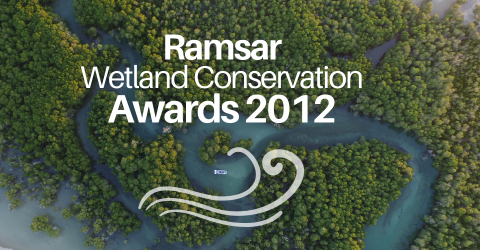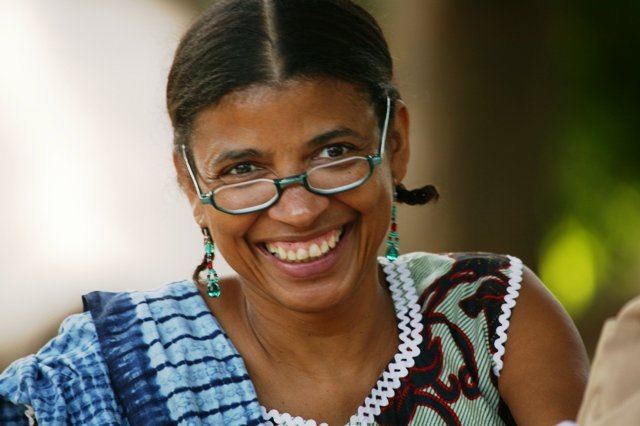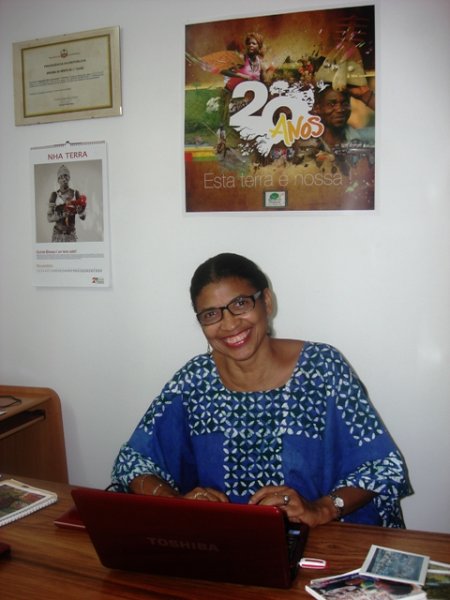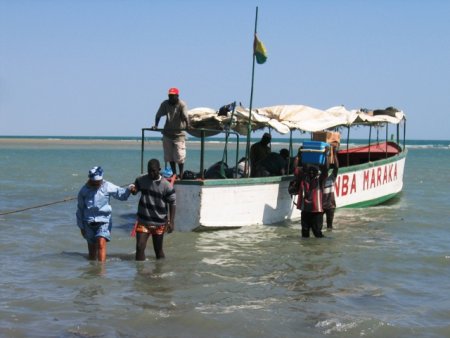
Award for Wetland Management 2012

Ms Augusta Henriques, Secretary General, TINIGUENA, Guinea-Bissau
The Ramsar Award for Management is given to Ms Augusta Henriques for her central role in the foundation of the NGO Tiniguena (“This Land is Ours”) in 1991 and for her long-term leadership and work with communities towards the creation of a Community Marine Protected Area at Urok Islands – the first marine protected area recognized by the Government of Guinea-Bissau. In the Bijagós Archipelago, Ms Henriques created this community marine protected area, comprised of mangroves and tidal flats and home to many bird and other species, among them marine turtles and manatees.
Ms Henriques has carried out exemplary and innovative work with local communities to maintain the local culture and allow it to evolve, and at the same time to ensure sustainable livelihoods. The system of community management promoted by Ms Henriques and Tiniguena has in particular enabled the replenishment of the fish stocks. She has been very attentive to the involvement of all stakeholders at of all levels of society, including women and youth. Dialogue between all villages of the archipelago is one of the keys to the success of Ms Henriques, as it has helped the local community members to reach a common understanding of the rules for access and use of the area and its resources. Central to Ms Henriques’ work is the importance of empowerment of the local populations in the management of their natural resources, the successful inclusion of government institutions, exchanges with similar projects in the region and fundraising with international institutions.
Ms Henriques has put the Convention's principles at the heart of her work and has collaborated with the Administrative Authority in Guinea-Bissau. In her country and in the region, she has been working in partnership with some of the Convention’s IOPs and other international organisations such as IUCN, Wetlands International, WWF, and the Banc d’Arguin Foundation (FIBA). She has played an important role in establishing a network of marine protected areas in West Africa, and in a programme for coastal and marine areas conservation. Her innovative approach, intelligence, tireless effort and her dedication make Ms Henriques one of the major figures of environmental conservation in Guinea-Bissau and in West Africa.
Interview with Ms Augusta Henriques
Could you say something about your background and the history of Tiniguena?
In our local language, TINIGUENA means “This Land is Ours”. This NGO was founded on 5 June 1991 with a mission to “Promote participatory and sustainable development based on the conservation of natural and cultural resources and the practice of citizenship”. The vision of Tiniguena’s founders was that Guinea-Bissau should be a place where populations can live in peace, dignity and prosperity and have a right to participate in and benefit from their country’s development while having ownership and development of their natural and cultural heritage – for the well-being of present and future generations.
Since its creation Tiniguena has become a reference nationally in the fields of environment, participatory development and citizenship, these being its three fields of action. In recent years, the organization has updated its chosen themes by taking up questions related to enhancing the value of biodiversity and of related local knowledge, of genetic heritage, and of community rights with the aim of promoting food sovereignty. These issues are dealt with in its Programme “L’Espace de la Terre” [The Space for the Earth]. The Urok Programme deals with wetland conservation, participatory management of a Marine Protected Area, as well as saving the cultural heritage and promotion of gender, equity, and local development – all of this in the perspective of priority access rights and sovereignty of resident communities in their own territory. The Programme “Jeunesse et Citoyenneté” [Youth and Citizenship Programme] deals with themes which are at the heart of the organization’s information, awareness raising and advocacy work, such as the practice of land-grabbing, biofuels, extractive industries, coastal zone and wetland conservation, good natural resources governance, the right to peace and development. Youth occupies a central place in Tiniguena’s activities. Tiniguena’s New Generation, which involves teenagers who have participated in 14 study tours to natural and cultural heritage sites, is considered as a pool for training youth leaders and for future citizens committed to the conservation of the natural and cultural heritage, and to the country’s sustainable development.
When did you become aware of the value of wetlands for Guinea-Bissau’s population? And how did you find out about the Convention and how it could be useful to your work?
I became aware of the value of wetlands 25 years ago, while preparing the national coastal zone planning programme, which was carried out with the help of IUCN, and which highlighted the role of wetlands. At this time, the main wetland of the country, the Cufada lakes, was designated a Ramsar site, which was an opportunity to promote understanding of the values and functions of wetlands.
In this context, and encouraged by the raising awareness created by the momentum, I answered the request made by the Urok islands communities, in the Bijagós Archipelago, for support in their resource conservation efforts against non-resident fishermen and, later, against projects for tourism development of a sacred island.

Talk about your work with the Convention – can you say more about this, and about the Convention’s importance and impact in Guinea-Bissau?
The Convention enabled the designation and protection of the main wetland of Guinea-Bissau, i.e. the Cufada lakes, which are the main freshwater reservoir of the Quínara region (in the south of the country) and a biodiversity hotspot. The work carried out around this designation, which Tiniguena disseminated through an education campaign on Cufada, contributed to the awareness-raising of the values of wetlands at national level. This turned out to be most important as a large part of the country, with its system of rias and its large mangrove areas on the one hand, and the Bijagos Archipelago on the other, can be considered a vast wetland.
Do you use the Convention and its guidance material? And if so how?
We use mainly the Convention guidelines to get inspiration from the principles and values recommended for wise use of wetland ecosystems. We hope that we can bring about the Urok Islands Complex (Bijagós Archipelago Biosphere Reserve) designation as a Ramsar site in the near future. The site is characterised by important migratory water bird populations, and the presence of large tidal flat and mangrove areas.
It seems that you work in a collaborative way, including NGOs and Government bodies together with representatives of local and indigenous communities. Could you say more about your approach?
Tiniguena’s present work in the Urok Islands Community Marine Protected Area (CMPA) consists mainly in facilitating a participatory governance process of this CMPA, which it does by encouraging a strong involvement of local communities, and the participation of other stakeholders such as traditional and administrative local authorities, the central CMPA oversight body (IBAP), the national maritime surveillance service (Fiscap), the fisheries research and follow-up institution (CIPA), and the small-scale fisheries directorate (Pescarte) – all of which are members of the Urok CMPA consultation roundtable. Consultation is structured around management bodies which enable collective decision-making at annual general assembly meetings where all villages of the three islands of the complex are represented, with advice from the Technical and Scientific Council and approval by the Council of Elders. Tiniguena also supports a process of intensive socio-cultural activities for youth, in order to encourage new cultural syntheses which will build a bridge between tradition and modernity. Tiniguena supports community development initiatives to improve the living environment of the residents, which in turn strengthens the adherence of an ever growing group of resident population.
Do you have any general messages about the importance of wise use of wetlands?
In countries of the South such as Guinea-Bissau, natural resources play a central role for the economy and for the peoples’ food security. In order to preserve the productivity of these natural resources, ecosystems must be kept healthy. To do so, it is essential that communities keep control over their territory and benefit from recognized priority access rights. If they have the means, the confidence and the long-term guarantees that their rights will be respected, communities are in the best position and are interested in ensuring wise use of wetlands. Through their culture, their knowledge and their dependency on natural resources, they are the true guardians of their sustainability.
How does “Ramsar” (Ramsar guidance material, principles, mission…) fit into your philosophy and Tiniguena’s programme?
Tiniguena’s philosophy and programme are based on the following principles:
- The participatory approach in initiating projects and managing wetlands and their resources;
- The recognition and optimal use of local knowledge in the management of natural areas and resources;
- The recognition of priority or exclusive access rights of resident communities;
- Responsible and wise use of natural resources;
- Participative follow-up of a few indicators of the status of the resources and of the well being of the communities;
- The importance of information, awareness raising and education of local communities, of the general public, and of decision-makers.
These principles, which guide Tiniguena’s action, coincide broadly with the Convention’s principles.
How do you feel about receiving the Ramsar Award? How will you leverage this for the future of your work?

I feel great pride for the work accomplished for wetlands by my organization, Tiniguena. The prestige conferred by this international recognition will benefit the cause of wetland conservation in Guinea-Bissau. In particular it will benefit the advocacy work to obtain the designation of the Urok CMPA as a Ramsar Site, and it will also benefit the other MPAs of Guinea-Bissau. It seems clear that receiving this Award will bring us more audience and stronger influence on the national authorities, as well as on the international conservation organization partners of Guinea-Bissau such as IUCN, of which Tiniguena is a member.
In your opinion, what are the most important aspects of your achievements that you would like to see highlighted in the context of the Ramsar Award?
- The work accomplished by Tiniguena over 20 years in discovering, informing and raising awareness of the large areas of natural and cultural heritage of Guinea-Bissau, which has contributed to the emergence of a feeling of national pride and has highlighted the network of Protected Areas which today cover approximately 15% of the national territory;
- Training of the young people who are more involved in environmental matters (Tiniguena’s New Generations – TNG) and the awakening of a growing environmental awareness within Guinea-Bissau society;
- The creation of the Urok CMPA, the first of its kind in the country, which influenced the framework law on Protected Areas in Guinea-Bissau, which now recognizes the principle and the model of community management areas;
- The process of creation and of participatory management of the Urok CMPA, which is considered at regional level as an example of participatory local governance integrating nature, culture, and development, while also inviting youth to become involved as the driving force to tackle future challenges;
- The economic and socio-cultural valuation work of the products of biodiversity has materialized as the line “kil ki di nos ten balur”. Products are marketed at national level under the label “Products of the Land”. All of this led to an increased demand for and consumption of local produce.
More Information:
www.tiniguena.org